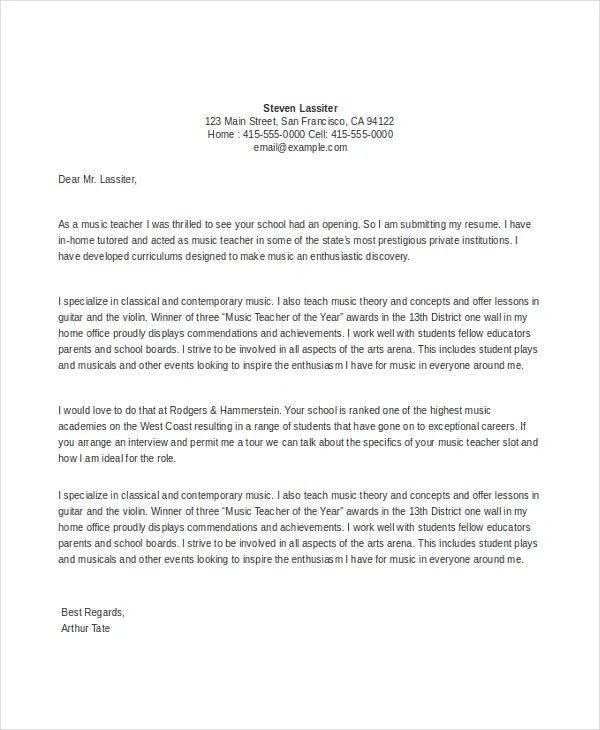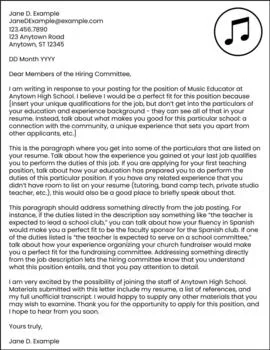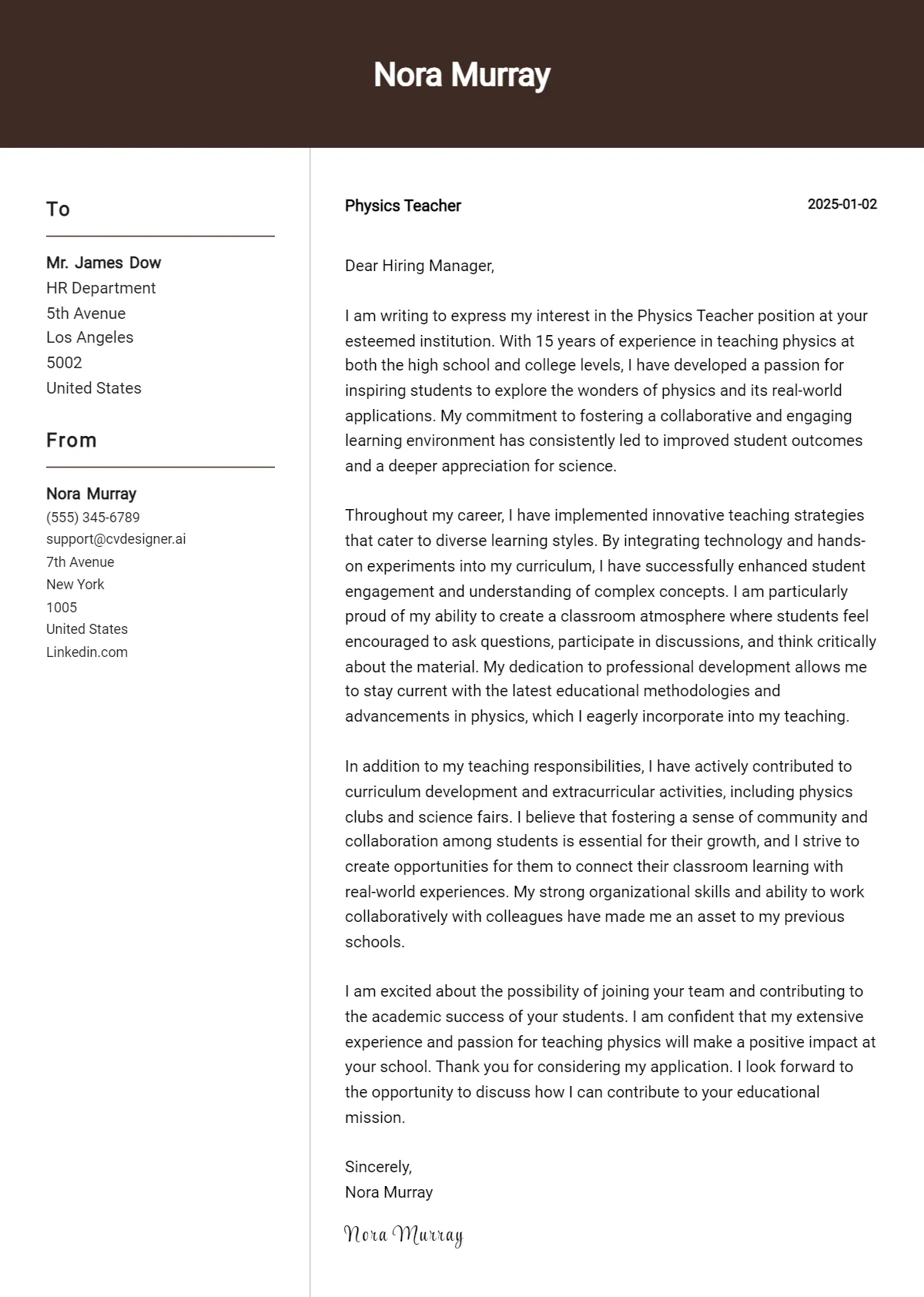Crafting the Perfect Music Teacher Cover Letter
A cover letter is your initial introduction to a potential employer, and for a music teacher, it’s an opportunity to showcase not just your musical abilities but also your passion for education and your ability to inspire young musicians. Crafting the perfect cover letter is crucial for making a strong first impression and securing an interview. This involves a strategic approach, highlighting key aspects of your qualifications and tailoring the letter to the specific requirements of the school or institution. The best cover letters are concise, well-written, and demonstrate a clear understanding of the role and the school’s values. They avoid generic language and instead, provide specific examples of your accomplishments and teaching style. The letter should be a reflection of your personality, enthusiasm, and dedication to fostering a love of music in students. It’s your first chance to show that you’re not just a music teacher, but a passionate educator who can make a difference in the lives of your students.
Highlighting Your Musical Expertise
Your musical expertise is the foundation of your cover letter. This section should clearly articulate your proficiency in music. Detail your musical background, including your instrument(s) of expertise, your performance experience (solo, ensemble, etc.), and any formal training or degrees you have. It’s important to be specific; for example, instead of saying you ‘play piano,’ mention your level of proficiency (e.g., ‘proficient in piano, with experience up to Grade 8 level’) and any specializations (e.g., ‘specializing in classical piano performance’). If you are also a composer or arranger, highlight those skills as well. Mention any awards or recognitions you have received. Consider how your musical background aligns with the needs of the school. Do they have specific programs (e.g., band, choir, orchestra)? Emphasize the instruments you play or teach that align with those programs. The goal is to demonstrate that you possess the skills and knowledge to effectively teach music at the required level, and that you have a deep passion for music that you can pass on to your students.
Showcasing Your Teaching Philosophy

Your teaching philosophy is a critical element of your cover letter. This section allows you to express your beliefs about music education, and how you inspire students. Your teaching philosophy should articulate your approach to music education, including your goals for students, your preferred teaching methods, and your approach to classroom management. Explain how you create a positive and engaging learning environment. Do you focus on fostering creativity, technical skill, or performance? Mention how you differentiate instruction to meet the needs of diverse learners. Do you incorporate technology, group projects, or other innovative techniques? Highlight how you promote student engagement and participation. Do you use assessment methods, like performance-based tasks, quizzes, or written assignments? Above all, demonstrate your passion for music and your desire to inspire students to love music. It’s a great way to establish a connection with the reader and show them that you are not only qualified but also a great cultural fit.
Emphasizing Relevant Experience
Detail your teaching experience. This section should provide specific examples of your teaching roles, including the grade levels you have taught, the subjects you have covered, and the programs you have been involved in. Describe your responsibilities, highlighting your successes and contributions. Focus on experiences that align with the job requirements. If the school is looking for a band director, emphasize your band-leading experience. If they emphasize choral music, showcase your experience in choir. Use action verbs to describe your accomplishments. For example, instead of saying ‘I taught music,’ you might say ‘I developed and implemented a comprehensive music curriculum for grades 3-5, resulting in a 20% increase in student participation in school concerts.’ Be clear and concise, and always quantify your achievements whenever possible. The goal is to provide the hiring committee with a clear picture of your relevant experience and show them how you can contribute to their music program.
Quantifying Your Achievements
Quantifying your achievements makes your cover letter more compelling. Rather than making broad statements, use numbers and data to demonstrate your impact. For instance, instead of saying ‘I improved student performance,’ say ‘I improved student performance by 15% on standardized music assessments.’ Mention any notable accomplishments. Did your students win awards, perform at prestigious events, or participate in successful fundraising campaigns? Include any data related to student enrollment in music programs. Did the number of students in your band or choir increase under your direction? Quantify these results to demonstrate the impact of your teaching. Use specific metrics. Did you implement a new curriculum or program that led to a specific outcome? Make sure you provide data points, as quantifiable data can strongly influence a hiring manager. Quantifiable achievements not only showcase your abilities but also underscore the tangible results you have delivered in your past roles.
Tailoring Your Letter to the School

Tailoring your cover letter to the specific school is essential for demonstrating your interest. Research the school and its music program. Visit their website, read about their mission and values, and review the current activities of their music department. Demonstrate that you have taken the time to learn about the school. Address the needs of the school directly. If the job description highlights specific requirements or priorities, address those points in your letter. If the school has a particular musical focus (e.g., jazz, classical, contemporary), highlight your experience or expertise in that area. Customizing the letter is a very effective way to demonstrate that you understand the school’s unique culture and needs. The hiring committee will quickly be able to see how well you fit in. It also shows your genuine interest and can significantly increase your chances of being selected for an interview.
Addressing the Hiring Manager
Whenever possible, address your cover letter to a specific person, such as the hiring manager or the principal of the school. If you can’t find the name online, try calling the school and asking. Using a name personalizes your letter and shows that you’ve done your research. If you are unable to find a name, use a professional greeting such as ‘Dear Hiring Committee’ or ‘Dear [School Name] Principal.’ Avoid generic greetings such as ‘To Whom It May Concern.’ In the letter, mention where you found the job posting. This can help the hiring manager track the effectiveness of their recruitment efforts. Close your letter with a professional and enthusiastic tone. Reiterate your interest in the position and thank the hiring manager for their time and consideration.
Including a Compelling Call to Action
End your cover letter with a clear call to action. State your availability for an interview and express your enthusiasm for the opportunity. Make it easy for the hiring manager to contact you. Provide your phone number and email address. You can also offer to provide additional materials, such as references or a portfolio of your work. Be sure to thank the hiring manager for their time and consideration. Express your enthusiasm for the opportunity to discuss your qualifications in more detail. Ensure the call to action is confident, professional, and leaves the reader with a strong impression. A well-crafted call to action encourages the hiring manager to take the next step. It increases the likelihood of you moving forward in the application process. Ultimately, the cover letter is your opportunity to make a memorable and convincing case. It should leave the hiring manager eager to learn more about you and your skills.
